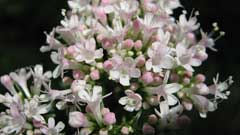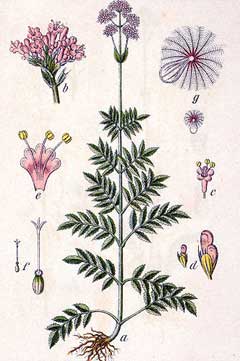 |
|
commons.wikimedia.org/wiki/User:Barend |
 |
| commons.wikimedia.org/wiki/File:Valeriana_sambucifolia_Sturm51.jpg |
Translate this page:
Summary
Physical Characteristics

 Valeriana sambucifolia is a PERENNIAL growing to 1.5 m (5ft).
Valeriana sambucifolia is a PERENNIAL growing to 1.5 m (5ft).
See above for USDA hardiness. It is hardy to UK zone 5 and is not frost tender. It is in flower from June to August, and the seeds ripen from July to September. The species is hermaphrodite (has both male and female organs) and is pollinated by Insects.
Suitable for: light (sandy), medium (loamy) and heavy (clay) soils. Suitable pH: mildly acid, neutral and basic (mildly alkaline) soils. It can grow in semi-shade (light woodland) or no shade. It prefers moist soil.
UK Hardiness Map
US Hardiness Map
Synonyms
V. officinalis sambucifolia. (Mikan.f.)Celak.
Plant Habitats
Woodland Garden Sunny Edge; Dappled Shade;
Edible Uses
Edible Parts: Seed
Edible Uses: Condiment Tea
Young leaves - cooked[105]. Seed[172]. No further details are given but the seeds of other members of this genus are parched and then eaten. An essential oil from the leaves and root is used as a flavouring in ice cream, baked goods, condiments etc[183]. The leaves can also be used as a condiment[61]. The plant is used in moderation as a herbal tea[183].
References More on Edible Uses
Medicinal Uses
Plants For A Future can not take any responsibility for any adverse effects from the use of plants. Always seek advice from a professional before using a plant medicinally.
Antispasmodic Carminative Diuretic Eczema Hypnotic Nervine Sedative Stimulant
Valerian is a well-known and frequently used medicinal herb that has a long and proven history of efficacy. It is noted especially for its effect as a tranquilliser and nervine, particularly for those people suffering from nervous overstrain[4, 222]. Valerian has been shown to encourage sleep, improve sleep quality and reduce blood pressure[254]. It is also used internally in the treatment of painful menstruation, cramps, hypertension, irritable bowel syndrome etc[238, 254]. It should not be prescribed for patients with liver problems[238]. Externally, it is used to treat eczema, ulcers and minor injuries[238]. The root is antispasmodic, carminative, diuretic, hypnotic, powerfully nervine, sedative and stimulant[4, 7, 9, 14, 21, 46, 147, 165, 192, 218]. The active ingredients are called valepotriates, research has confirmed that these have a calming effect on agitated people, but are also a stimulant in cases of fatigue[222]. The roots of 2 year old plants are harvested in the autumn once the leaves have died down and are used fresh or dried[4, 9, 238]. The fresh root is about 3 times as effective as roots dried at 40° (the report does not specify if this is centigrade or fahrenheit), whilst temperatures above 82° destroy the active principle in the root[240]. Use with caution[21, 238], see the notes above on toxicity.
References More on Medicinal Uses
The Bookshop: Edible Plant Books
Our Latest books on Perennial Plants For Food Forests and Permaculture Gardens in paperback or digital formats.

Edible Tropical Plants
Food Forest Plants for Hotter Conditions: 250+ Plants For Tropical Food Forests & Permaculture Gardens.
More

Edible Temperate Plants
Plants for Your Food Forest: 500 Plants for Temperate Food Forests & Permaculture Gardens.
More

More Books
PFAF have eight books available in paperback and digital formats. Browse the shop for more information.
Shop Now
Other Uses
Compost Essential Liquid feed Repellent
The plant yields about 1% of an essential oil from the roots[7, 238]. It is used in perfumery to provide a 'mossy' aroma[57, 61, 238], though the scent is considered to be disagreeable by many people[207]. The dried roots are also placed in linen cupboards and clothes drawers in order to scent the clothes[4]. The dried root attracts rats and cats, it can be used as a bait to lure them away from other areas[100]. An ingredient of 'QR' herbal compost activator[32]. This is a dried and powdered mixture of several herbs that can be added to a compost heap in order to speed up bacterial activity and thus shorten the time needed to make the compost[K]. The plant can also be used to make a very good liquid plant feed[14, 18, 201]. It attracts earthworms[14, 18]. The leaves are very rich in phosphorus[201].
Special Uses
Scented Plants
References More on Other Uses
Cultivation details
Succeeds in ordinary garden soil[1], preferring a moist site[7, 17]. Succeeds in full sun or in partial shade[233]. This species is considered to be no more than a sub-species of V. officinalis by many botanists[200], it has the same uses as that species[4]. Often grown in the herb garden and also sometimes grown commercially as a medicinal herb[1, 200]. Cats are very fond of this plant, particularly the powdered root[1, 4, 20]. The root also attracts rats[14]. A good companion for most plants.
References Carbon Farming Information and Carbon Sequestration Information
Temperature Converter
Type a value in the Celsius field to convert the value to Fahrenheit:
Fahrenheit:
The PFAF Bookshop
Plants For A Future have a number of books available in paperback and digital form. Book titles include Edible Plants, Edible Perennials, Edible Trees,Edible Shrubs, Woodland Gardening, and Temperate Food Forest Plants. Our new book is Food Forest Plants For Hotter Conditions (Tropical and Sub-Tropical).
Shop Now
Plant Propagation
Seed - sow spring in a cold frame and only just cover the seed because it requires light for germination[200]. Prick out the seedlings into individual pots when they are large enough to handle and plant out into their permanent positions in the summer if sufficient growth has been made. If the plants are too small to plant out, grow them on in the greenhouse or frame for their first winter and plant them out early in the following summer. Division in spring. Larger divisions can be planted out direct into their permanent positions. We have found that it is best to pot up smaller divisions and grow them on in light shade in a greenhouse or cold frame until they are growing away well. Plant them out in the summer or the following spring.
Other Names
If available other names are mentioned here
Native Range
EUROPE: Europe (w. & c.)
Weed Potential
Right plant wrong place. We are currently updating this section.
Please note that a plant may be invasive in one area but may not in your area so it's worth checking.
Conservation Status
IUCN Red List of Threatened Plants Status :

Growth: S = slow M = medium F = fast. Soil: L = light (sandy) M = medium H = heavy (clay). pH: A = acid N = neutral B = basic (alkaline). Shade: F = full shade S = semi-shade N = no shade. Moisture: D = dry M = Moist We = wet Wa = water.
Now available:
Food Forest Plants for Mediterranean Conditions
350+ Perennial Plants For Mediterranean and Drier Food Forests and Permaculture Gardens.
[Paperback and eBook]
This is the third in Plants For A Future's series of plant guides for food forests tailored to
specific climate zones. Following volumes on temperate and tropical ecosystems, this book focuses
on species suited to Mediterranean conditions—regions with hot, dry summers and cool, wet winters,
often facing the added challenge of climate change.
Read More
Expert comment
Author
Mikan.f.
Botanical References
50200
Links / References
For a list of references used on this page please go here
Readers comment
| Add a comment |
|
If you have important information about this plant that may help other users please add a comment or link below. Only comments or links that are felt to be directly relevant to a plant will be included. If you think a comment/link or information contained on this page is inaccurate or misleading we would welcome your feedback at [email protected]. If you have questions about a plant please use the Forum on this website as we do not have the resources to answer questions ourselves.
* Please note: the comments by website users are not necessarily those held by PFAF and may give misleading or inaccurate information.
To leave a comment please Register or login here All comments need to be approved so will not appear immediately.
|
Subject : Valeriana sambucifolia
|
|
|
|